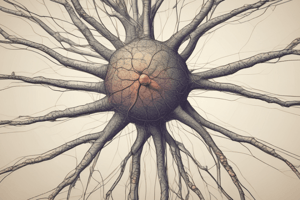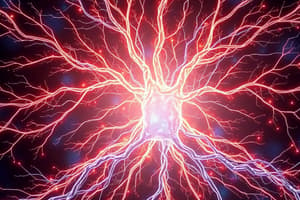Podcast
Questions and Answers
What is the threshold value that must be reached to initiate an action potential?
What is the threshold value that must be reached to initiate an action potential?
- -55mV (correct)
- -70mV
- -90mV
- -40mV
Graded potentials are self-propagating electrical signals.
Graded potentials are self-propagating electrical signals.
False (B)
What is the refractory period?
What is the refractory period?
A brief period when an axon cannot generate an action potential or requires greater stimulation to do so.
The ______________ is involved in the exocytosis of neurotransmitters from synaptic vesicles.
The ______________ is involved in the exocytosis of neurotransmitters from synaptic vesicles.
Match the segments of a neuron with their primary functions:
Match the segments of a neuron with their primary functions:
Which of the following statements about action potentials is correct?
Which of the following statements about action potentials is correct?
Larger and unmyelinated axons conduct action potentials faster than smaller and myelinated axons.
Larger and unmyelinated axons conduct action potentials faster than smaller and myelinated axons.
What is a neurotransmitter?
What is a neurotransmitter?
What structures make up the nervous system?
What structures make up the nervous system?
Glial cells are responsible for initiating and transmitting graded potentials.
Glial cells are responsible for initiating and transmitting graded potentials.
What is the resting membrane potential (RMP) of a neuron?
What is the resting membrane potential (RMP) of a neuron?
________ are clusters of neuron cell bodies located along a nerve.
________ are clusters of neuron cell bodies located along a nerve.
Match the type of neuron with its classification:
Match the type of neuron with its classification:
What is the primary function of glial cells?
What is the primary function of glial cells?
Myelination occurs in both the CNS and PNS.
Myelination occurs in both the CNS and PNS.
What are the two types of axonal transport?
What are the two types of axonal transport?
The neurotransmitter release occurs from the __________ segment of the neuron.
The neurotransmitter release occurs from the __________ segment of the neuron.
Which type of glial cell in the CNS is responsible for myelination?
Which type of glial cell in the CNS is responsible for myelination?
Flashcards
Nervous System Function
Nervous System Function
Interprets and controls sensory input (from receptors) and motor output (to effectors).
Neuron
Neuron
A specialized cell that transmits information in the nervous system.
Synapse
Synapse
The junction between two neurons or a neuron and an effector.
Glial Cells
Glial Cells
Signup and view all the flashcards
Resting Membrane Potential (RMP)
Resting Membrane Potential (RMP)
Signup and view all the flashcards
Myelination
Myelination
Signup and view all the flashcards
Neuron Structure
Neuron Structure
Signup and view all the flashcards
Receptive Segment
Receptive Segment
Signup and view all the flashcards
Initial Segment
Initial Segment
Signup and view all the flashcards
Axon Regeneration
Axon Regeneration
Signup and view all the flashcards
CNS vs PNS
CNS vs PNS
Signup and view all the flashcards
Conductive Segment
Conductive Segment
Signup and view all the flashcards
Nerve Classification
Nerve Classification
Signup and view all the flashcards
Refractory Period
Refractory Period
Signup and view all the flashcards
Saltatory Conduction
Saltatory Conduction
Signup and view all the flashcards
Transmissive Segment
Transmissive Segment
Signup and view all the flashcards
Action Potential
Action Potential
Signup and view all the flashcards
Graded Potential
Graded Potential
Signup and view all the flashcards
Study Notes
Nervous System: Nervous Tissue
- Nervous system interprets and controls sensory input from receptors and motor output to effectors (composed of brain, spinal cord, nerves, and ganglia)
- Nervous tissue is excitable neurons that transmit graded and action potentials, and glial cells that support and protect them
- Synapse is the functional junction between neurons or neuron and effector (chemical or electrical)
- Glial cells are distinct nervous tissue cells
- Establishing and changing resting membrane potential (RMP) depends on various pumps and channels within neuron's plasma membrane
General Functions of the Nervous System
- Collects information through receptors (sensory input)
- Processes and evaluates information
- Responds through motor output to effectors (muscles or glands)
Organization of the Nervous System
- Structurally organized into central nervous system (CNS) and peripheral nervous system (PNS)
- Functionally organized into sensory component and motor component
Nerves and Ganglia
- Nerve is a collection of axons in the PNS, enclosed by epineurium, perineurium, and endoneurium
- Ganglion is a cluster of neuron cell bodies along a nerve
General Characteristics of a Neuron
- Excitability, conductivity, secretion, and longevity
- Typically amitotic
Neuron Structure
- Cell body
- Dendrites
- Axon
Neuron Transport
- Substances transported between cell body and synaptic knobs via fast and slow axonal transport
Classification of Neurons
- Structurally (multipolar, bipolar, unipolar, anaxonic)
- Functionally (sensory neurons, motor neurons, interneurons)
General Characteristics of Glial Cells
- Nonexcitable cells that support and protect neurons
Types of Glial Cells
- CNS: astrocytes, ependymal cells, microglia, oligodendrocytes
- PNS: satellite cells and neurolemmocytes
Myelination
- Process of wrapping axon with myelin (neurolemmocytes in PNS, oligodendrocytes in CNS)
- Increases speed of action potential propagation
Axon Regeneration
- Limited to PNS axons
- Requires intact cell body and critical amount of neurilemma
Pumps and Channels (in neurons)
- Membrane proteins that facilitate ion movement across the neuronal membrane. Some are distributed along the entire neuron, others in specific functional segments.
Neurons at Rest
- Resting membrane potential (RMP) is -70mV
- Gated channels are closed
- Na+, K+, Cl-, and Ca2+ concentration gradients exist
Receptive Segment
- Includes dendrites and cell body
- Forms and propagates graded potentials (EPSPs and IPSPs)
Initial Segment
- Summation of EPSPs and IPSPs determines if threshold (-55mV) is reached, initiating action potential
Conductive Segment
- Propagates action potential along axon
- Involves depolarization and repolarization.Refractory periods(time needed for another action potential)
Transmissive Segment
- Exocytosis of neurotransmitter from synaptic vesicles
- Causes a response in the target cell
Graded Potentials vs Action Potentials
- Graded are short-lived signals in dendrites & cell bodies, caused by chemically gated channels.
- Action are long-lived signals initiated in the initial segment and propagate along the axon, caused by voltage gated channels
Velocity of Action Potential Propagation
- Faster in larger and myelinated axons (classified into three groups based on their velocity).
Frequency of Action Potentials
- Increased with increased stimulation.
Classification of Neurotransmitters
- Classified as acetylcholine, biogenic amines, amino acids, and neuropeptides.
Neuromodulation
- Release of chemicals (other than neurotransmitters) that influence neuron responsiveness. This can either facilitate or inhibit the response to a neurotransmitter.
Studying That Suits You
Use AI to generate personalized quizzes and flashcards to suit your learning preferences.




